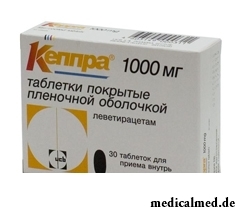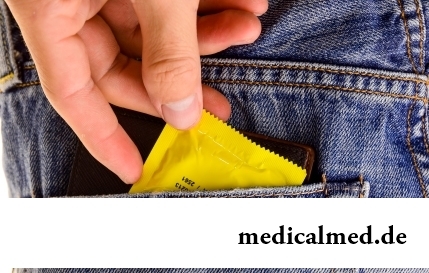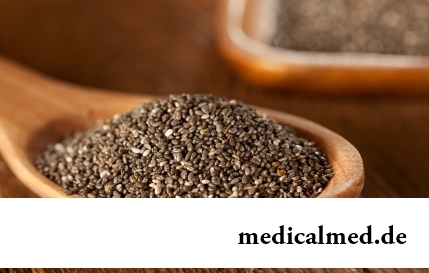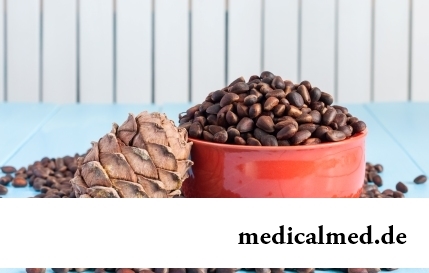





Keppra
Application instruction:
 Keppra – anticonvulsant, antiepileptic drug, active in the relation of both generalized, and focal epileptic seizures.
Keppra – anticonvulsant, antiepileptic drug, active in the relation of both generalized, and focal epileptic seizures.
Form of release and structure
Keppra is let out in the following dosage forms:
- Concentrate for preparation of solution for infusions: transparent colourless solution (on 5 ml in glass bottles, on 5 bottles in blister strip packagings, on 2 packagings in a cardboard pack);
- Tablets, film coated (blue – 250 mg, light yellow – 500 mg, white – 1000 mg): an oval form, biconvex, on one of the parties – risk, "ucb" dividing an engraving and a dosage (ucb|250, ucb|500, ucb|1000), on a break white, homogeneous (on 10 pieces in blisters/blister strip packagings, on 3 or 6 blisters/packagings in a cardboard pack);
- Solution for intake: transparent, almost colourless liquid with a characteristic smell (on 300 ml in bottles from dark glass complete with the screw-on cover from white polypropylene with function of protection against children and the measured syringe (polyethylene/polystyrene), on 1 set in a cardboard pack).
For preparation of infusion solution is a part of 5 ml of a concentrate:
- Active agent: to levetiratseta – 500 mg;
- Auxiliary components: sodium chloride – 45 mg, trihydrate sodium acetate – 8,2 mg, 10% glacial acetic acid – before achievement рН 5,5, water for injections – to 5 ml.
Is a part of 1 tablet:
- Active agent: to levetiratseta – 250 mg, 500 mg, 1000 mg;
- Auxiliary components (250/500/1000 mg respectively): silicon dioxide – 5,188/10,375/20,75 mg, croscarmellose sodium – 10,75/21,5/43 mg, a macrogoal of 6000 - 2,5/5/10 mg, magnesium stearate – 0,313/0,625/1,25 mg;
- Film cover (250/500/1000 mg respectively): Opadry 85F20694 – 8,063 of mg / Opadry 85F32004 – 16,125 of mg / Opadry 85F18422 – 32,25 of mg.
For oral administration is a part of 1 ml of solution:
- Active agent: to levetiratseta – 100 mg;
- Auxiliary components: sodium citrate – 1,05 mg, monohydrate of citric acid – 0,06 mg, methylparahydroxybenzoate – 2,7 mg, пропилпарагидроксибензоат – 0,3 mg, глицирризат ammonium – 1,5 mg, 85% глицерол – 235,5 mg, мальтитол – 300 mg, to potassium atsesulfa – 4,5 mg, grape fragrance 501040A - 0,3 of mg, the purified water – 504 mg.
Indications to use
Keppra along with other drugs is applied to treatment of the following states / diseases:
- Epilepsy: partial attacks with secondary generalization or without at adults and children are more senior than 1 month (solution for oral administration), 4 years (infusion solution, tablets);
- Juvenile myoclonic epilepsy: myoclonic spasms at adults and children are more senior than 12 years;
- Idiopathic generalized epilepsy: primary and generalized convulsive (toniko-clonic) attacks at adults and children are more senior than 12 years.
As monotherapy (choice drug) Keppra is used at partial attacks with secondary generalization or without at adults and teenagers from 16 years with for the first time the diagnosed epilepsy.
The concentrate to preparation of solution for infusions is applied temporarily when the peroral forms of medicine cannot be taken for any reason.
Contraindications
- Children's age: up to 1 month – solution for oral administration (efficiency and safety of use of drug are not established), up to 4 years – infusion solution, tablets;
- Hypersensitivity to derivatives of a pirrolidon including a levetiratsetam, and also other components.
With care therapy by Keppra is carried out at patients at advanced age (of 65 years), at liver diseases to stages of a decompensation and a renal failure.
Route of administration and dosage
Duration of a course of treatment and the choice of a dosage form of Keppra is made by the attending physician.
Solution for intake, tablets, coated
Drug in the form of tablets or solution is accepted orally, dividing a daily dose into 2 equal receptions; tablets should be washed down with liquid in enough.
As choice drug for monotherapy of partial attacks with secondary generalization or without at adults and teenagers 16 years are more senior: an initial dose – 500 mg a day, divided into 2 receptions on 250 mg. 2 weeks later the dose can be increased to basic therapeutic – 1000 mg the day divided into 2 receptions on 500 mg. The maximum daily dose – 3000 mg divided into 2 receptions on 1500 mg.
As a part of complex therapy to children of 1 month before half a year to Keppr 2 times a day appoint in the form of solution for intake in an initial therapeutic dose 7 mg/kg. Depending on clinical performance and portability the dose can be increased to 21 mg/kg 2 times a day. Change of a dose a plus-minus of 7 mg/kg 2 times a day each 2 weeks before achievement of a minimal effective dose is allowed.
The recommended dosing of solution for intake to children before half a year – 2 times a day, depending on the body weight of the child (an initial dose / the maximum dose):
- 4 kg – 28-84 mg (0,3-0,85 ml);
- 5 kg – 35-105 mg (0,35-1,05 ml);
- 7 kg – 49-147 mg (0,5-1,5 ml).
At children and teenagers aged from half a year up to 17 years, with body weight to 50 kg, therapy there begin with a dose 10 mg/kg 2 times a day. Depending on portability of drug and clinical reaction the dose can be increased to 30 mg/kg 2 times a day (change of a dose on 10 mg/kg can be carried out each 2 weeks; it is necessary to use a minimal effective dose).
For children weighing 50 kg the mode of dosing same, as well as for adult patients is also more recommended.
The recommended drug dosing to children of half a year – 2 times a day, depending on the body weight of the child (an initial dose / the maximum dose):
- 6 kg – 60-180 mg (0,6-1,8 ml);
- 10 kg – 100-300 mg (1-3 ml);
- 15 kg – 150-450 mg (1,5-4,5 ml);
- 20 kg – 200-600 mg (2-6 ml);
- 25 kg – 250-750 mg;
- from 50 kg – 500-1500 mg.
To children 4 years are more senior it is necessary to begin therapy with the dose of 20 mg/kg a day divided into 2 receptions (10 mg/kg 2 times a day). Change of a dose on 20 mg/kg of body weight a day is carried out each 2 weeks before achievement of the recommended dose – 60 mg/kg a day (on 30 mg/kg 2 times a day). At intolerance of the recommended daily dose its decrease is possible. It is necessary to use a minimal effective dose.
Keppra is applied in the most suitable dosage and a dosage form depending on the weight of the patient and a required therapeutic dose.
Children weighing less than 20 kg are recommended to begin therapy with drug in the form of solution for intake.
Dosing of solution for intake is carried out the measured syringe with a nominal volume of 10 ml (1 g of the levetiratsetam) with scale interval of 25 mg (0,25 ml) which is included in the drug supply package. The drug dose measured for reception is parted in 200 ml of water.
The step-by-step instruction for dosing of solution for intake by means of the measured syringe:
- To open Keppra's bottle, having pressed a cap and having turned it counterclockwise;
- To insert the syringe adapter into a mouth of a bottle and, having convinced of good fixing, to place the syringe in the adapter;
- To turn a bottle a mouth from top to bottom;
- To gather a small amount of solution in the syringe, having pulled the piston down, further to press the piston up to remove vials of air;
- To fill the syringe with solution, having pulled the piston down to the division corresponding to the dose appointed by the doctor;
- To turn a bottle a bottom from top to bottom, to pull out the syringe from the adapter;
- To enter syringe contents into a children's small bottle or glass with water, having pressed against the stop on the piston;
- To completely drink contents of a children's small bottle or a glass;
- To wash out the syringe water;
- To close a bottle a plastic cover.
Infusion solution
The drug is administered intravenously kapelno within 15 minutes; the daily dose of solution is divided into 2 equal introductions.
Rolled into one a concentrate for preparation of solution for infusions 500 mg of a levetiratsetam (100 mg/ml) contain. The concentrate should be diluted with solvent not less than 100 ml.
The instruction for solution dosing (solvent volume – 100 ml, injection time – 15 min., introduction frequency – 2 times a day):
- 250 mg: 2,5 ml (1/2 ampoules of 5 ml) – 500 mg a day;
- 500 mg: 5 ml (1 ampoule of 5 ml) – 1000 mg a day;
- 1000 mg: 10 ml (2 ampoules on 5 ml) – 2000 mg a day;
- 1500 mg: 15 ml (3 ampoules on 5 ml) – 3000 mg a day.
As solvents it is recommended to use: Ringer's solution lactat for injections, 0,9% sodium chloride solution for injections, 5% dextrose solution for injections.
Solution is chemically stable for 24 hours at a temperature of 15-25 °C in packages from polyvinylchloride. However from the point of view of microbiological sterility drug should be used right after cultivation.
If necessary solution can be stored at a temperature of 2-8 °C for days provided that dilution was made in aseptic conditions. Responsibility for microbiological purity is born at the same time by the user.
The mode of dosing of solution for infusions completely corresponds described for peroral forms. Transition from intravenous (to) introductions to oral administration of Keppra can be also back made with preservation of frequency rate of use and a dose.
Features of use of Keppra at a renal failure: as to levetiratseta it is brought out of an organism by kidneys, at purpose of drug elderly patients and patients with a renal failure need to make dose adjustment depending on the clearance of creatinine (CC).
For men of KK it is calculated on the following formula:
KK (ml/min.) = (140 - age (the number of years)) × the body weight (kg)/72×Cl (mg/dl.)
Cl – concentration of serumal creatinine.
For women of KK is calculated multiplication of the received result by coefficient 0,85.
Correction of KK value taking into account the body surface area (BSA):
Cl (ml/min.) of/1,73 sq.m = Cl (ml/min.) × 1,73/PPT (sq.m).
The recommended dosing mode depending on degree of a renal failure (KK value):
- Norm (KK more than 80) – 500-1500 mg 2 times a day;
- Latent (KK 50-79) – 500-1000 mg 2 times a day;
- Compensated (KK 30-49) – 250-750 mg 2 times a day;
- Intermittent (KK less than 30) – 250-500 mg 2 times a day;
- Terminal (patients on a hemodialysis) – 500-1000 mg once a day.
In the first day of therapy of the patients who are on a hemodialysis reception of sating Keppra's dose – 750 mg is recommended. Further, after carrying out dialysis, it is necessary to accept/enter in addition 250-500 mg of a levetiratsetam.
At a renal failure at children dose adjustment of a levetiratsetam is made taking into account the degree of a renal failure and recommendations made for adults.
Dose adjustment is not required at easy and moderate severity abnormal liver functions. In case of dekompensirovanny abnormal liver functions and a renal failure size KK can not reflect real degree of a renal failure therefore at KK less than 70 ml/min. it is necessary to reduce a daily dose by 50%.
Side effects
The most frequent undesirable reactions: drowsiness, nasopharyngitis, headache, dizziness and fatigue.
Side effects from systems and bodies depending on emergence frequency (≥1/10 – it is very frequent; ≥1/100-<1/10 – it is frequent; ≥1/1000-<1/100 – infrequently; ≥1/10 000-<1/1000 – it is rare; <1/10 000 – it is extremely rare):
- Gepatobiliarny system: infrequently – change of functional trials of a liver; seldom – hepatitis, a liver failure;
- Respiratory system: often – cough;
- Immune system: seldom – DRESS syndrome (a syndrome of the medicinal induced hypersensitivity with an eosinophilia);
- Invasions and infections: very often – a nasopharyngitis; seldom – infection;
- Integuments: often – rash; infrequently – eczema, an itch, an alopecia; seldom – Stephens-Johnson's syndrome, a toxic epidermal necrolysis, a mnogoformny erythema;
- Musculoskeletal system: infrequently – a mialgiya, muscular weakness;
- Blood and lymphatic system: infrequently – a leukopenia, thrombocytopenia; seldom – an agranulocytosis, a pancytopenia (in some episodes with oppression of function of marrow), a neutropenia;
- Nervous system: very often – a headache, drowsiness; often – disturbance of balance, a spasm, dizziness, a tremor, a lethargy; infrequently – a memory impairment, amnesia, disturbance a coordination/ataxy, decrease in concentration of attention, paresthesia; seldom – dyskinesia, a choreoathetosis, a hyperkinesia;
- Metabolism: often – anorexia; infrequently – decrease or increase in body weight;
- General frustration: often – adynamy/fatigue;
- Organ of sight: infrequently – a sight illegibility, a diplopia;
- Acoustic organ: often – dizziness (вертиго);
- Alimentary system: often – diarrhea, dyspepsia, an abdominal pain, nausea, vomiting; seldom – pancreatitis;
- Mental disorders: often – hostility/aggression, a depression, alarm, sleeplessness, irritability, nervousness; infrequently – suicide intentions, attempts of a suicide, behavioural frustration, psychotic frustration, hallucinations, confusion of consciousness, irascibility, emotional lability, excitement, changeability of mood, the panic attacks; seldom – personal disorder, disturbance of process of thinking, a suicide;
- Injuries, complications of procedures: infrequently – accidental damages.
In general profiles of safety of a levetiratsetam in various age groups of children and adults are similar.
After cancellation of a levetiratsetam in some cases recovery of indumentum was observed.
Special instructions
Under the influence of food completeness of absorption of a levetiratsetam does not change, but absorption speed decreases a little.
In case of need the terminations of administration of drug its cancellation are recommended to be carried out step by step (lowering a single dose each 2–4 weeks by 500 mg). The dose decline for children should not exceed 10 mg/kg 2 times a day each 2 weeks, and for children is younger than half a year – 7 mg/kg 2 times a day each 2 weeks.
During transfer of patients into reception of a levetiratsetam the accompanying antiepileptic drugs are recommended to be cancelled gradually.
There are no data at Keppra's use for the children testimonial of any negative influence on their puberty and development, but there are unknown remote effects of influence of a levetiratsetam on ability to training, growth, functions of closed glands, fertility, sexual and intellectual development of children.
At diseases of kidneys and dekompensirovanny diseases of a liver prior to therapy it is necessary to pass a research of function of kidneys, perhaps, drug dose adjustment will be required.
The patients who are on a diet with sodium restriction have to consider that in a concentrate for preparation of solution for infusions the content of sodium in 1 ampoule – 0,83 mmol (19 mg).
There are messages on cases of suicide intentions, a suicide and attempts of a suicide during therapy levetiratsetamy therefore it is necessary to warn patients about need immediately to report to the attending physician about emergence of any suicide intentions or symptoms of a depression.
There is no clinical experience of use of a levetiratsetam infusionally more than 4 days.
It is impossible to use drug in case of emergence in solution of mechanical inclusions or changes of its coloring.
Solution for intake is contraindicated to use at disturbance of tolerance to fructose because of the maintenance of a maltitol.
Content in solution for intake of a propilparagidroksibenzoat and methylparahydroxybenzoate can be the cause of an allergy (including the delayed action).
Considering individual sensitivity to a levetiratsetam from TsNS (drowsiness cases at some patients are recorded), during therapy it is necessary to abstain from the occupations demanding speed of psychomotor reactions and the increased concentration of attention including from driving of motor transport.
Medicinal interaction
- Antiepileptic drugs (carbamazepine, Phenytoinum, valproic acid, ламотриджин, phenobarbital, габапентин, Primidonum and топирамат): mutually do not influence concentration of each other in plasma;
- Anticonvulsants (inductors of microsomal enzymes of a liver): at the children accepting Keppra, the clearance of a levetiratsetam is increased for 22%;
- Probenetsid, streptocides, non-steroidal anti-inflammatory drugs (NPVS), methotrexate: the effect of a levetiratsetam at a concomitant use with them is unknown; reception of a probenetsid 4 times a day on 500 mg reduces renal secretion of primary metabolite;
- Peroral contraceptive (levonorgestrel and ethinylestradiol): does not change levetiratseta at reception in a dose of 1000 mg a day their pharmacokinetics;
- Warfarin and digoxin – to levetiratseta at reception in a dose of 2000 mg a day does not change their pharmacokinetics;
- Warfarin, digoxin and peroral contraceptives: do not influence pharmacokinetics of a levetiratsetam;
- Topiramat: increases risk of development of anorexia;
- Antacids: there are no data on their influence on absorption of a levetiratsetam;
- Alcohol: there are no data on interaction with levetiratsetamy.
Terms and storage conditions
To store in the place, unavailable to children, at a temperature not above 25 °C.
Period of validity – 2 years.
Name of drug
Price
Drugstore
Keppra тбл п / about 250 mg No. 30, UCB Pharma Sector
880 rub.
 Network of the Moscow drugstores of IFC
Network of the Moscow drugstores of IFCKeppra тбл п/пл/о 500 mg No. 30, UCB Pharma Sector
1552 rub.
 Network of the Moscow drugstores of IFC
Network of the Moscow drugstores of IFCBlood of the person "runs" on vessels under huge pressure and at disturbance of their integrity is capable to shoot of distance to 10 meters.

Healthy lifestyle today in fashion, and many parents think of that the child from the early childhood played sports. To a Torah...
Section: Articles about health
Childbirth is the most important event in life of each woman. We are women we give birth to the new little man on this light. Now the tendency to that was outlined, as men want to participate in labor too. But there is a question and whether it is worth allowing the husband...
Section: Articles about health
It would seem, about it there can be no disagreements: water is necessary for a human body for normal life activity, and about how and when it should be drunk, all know. It turned out that the situation is not absolutely so: for many years there are very persistent delusions connected with this question. Let's consider the most widespread of them....
Section: Articles about health
During foot walks blood moves on vessels more actively and one and all bodies are supplied with a large amount of oxygen. N...
Section: Slideshow
The body of the person almost for 60% consists of water. It is so important for normal functioning of an organism that loss of only one and a half percent of liquid already leads to the most unpleasant effects. The problems connected with deficit of water can overtake and...
Section: Articles about health
Today about 30 diseases, sexually transmitted are known. Wide circulation of these illnesses is extremely promoted by the dual attitude towards them: on the one hand, most of people know about "shameful" diseases very little and do not aim at receiving detailed and reliable information, considering that such problems personally will never concern them. With another – there are delusions about STD which instill unreasonable confidence that troubles such...
Section: Articles about health
Dark circles (bruises) under eyes – a shortcoming with most of which often fight against the help of cosmetics (proofreaders, salons...
Section: Articles about health
Coffee – favourite drink of many. For the last decades it more than once already declared very harmful, extremely useful and even necessary for normal life activity. In spite of the fact that this product became for us usual for a long time, exists much...
Section: Articles about health
With age in a human body harmful substances collect. We receive them with food and water, at inhalation of the contaminated air, reception of medicines, use of household chemicals and cosmetics. A considerable part of toxins accumulates in a liver which main function is continuous purification of blood. This body begins to knock as any got littered filter, and efficiency of its work decreases....
Section: Articles about health
Tick-borne encephalitis – one of the most dangerous viral diseases which causative agents transfer and is given to people by ixodic mites. Эт...
Section: Articles about health
Almost each of us during life faced dissatisfaction with own body. At such moments, as a rule, we begin to shame ourselves, urgently we go on the most rigid diet promising minus of 10 kg in a week, or we exhaust ourselves in the gym to полусм...
Section: Articles about health
The number of long-livers is very small. One person from 5 thousand lives up to age of 90 years, and the centenary boundary steps over only one of 20 thousand. However, doctors claim that each of us is quite able to affect own destiny. At the same time it is not so much about living as long as possible, how many about an opportunity to keep physical and intellectual activity and to avoid decrepitude. We will also talk about the ways helping to achieve this result today....
Section: Articles about health
Epilepsy is one of widespread neurologic diseases. To parents, whose children suffer from this illness, it is necessary...
Section: Articles about health
At this plant there are a lot of names: tuberiferous sunflower, Jerusalem artichoke, solar root, earth pear. Contrary to popular belief, it is not an exotic plant at all. The wild girasol grows in a midland of Russia practically everywhere: at the edges of roads...
Section: Articles about health
Each person supports all life a SARS about 200 times. The peak of incidence falls on cold season, but it is possible to get sick with a temperature and a pharyngalgia, and sometimes and very possibly, even during a heat. The reasons for development of catarrhal diseases there is a set: from the weakened immunity till an excess portion of ice cream....
Section: Articles about health
The kid who was recently born is surrounded with love of adult family members and their cares without which the baby cannot exist....
Section: Articles about health
Musicotherapy – a treatment method which caused and causes a set of a controversy concerning its efficiency. However the facts are relentless: during the numerous researches curative impact of music on an organism was scientifically confirmed. Since then in a number of the countries a method...
Section: Articles about health
Within several decades of our compatriots convinced that the use of butter nasty affects a condition of coronary vessels. As a result the reputation of a product was impaired thoroughly a little, and many almost ceased to include it in the diet, having given preference "to safer" to vegetable fats. Meanwhile, the last researches showed that harm of butter for health is strongly exaggerated. But the product has a number of unique properties, to...
Section: Articles about health
The problem of diagnosis was and remains to one of the most important in medicine. From that, the reason недо will be how precisely defined...
Section: Articles about health
The chia plant, or the Spanish sage, is from South America. The indigenous people of the continent since ancient times used its seeds in food: small, but very nutritious kernels, in a form the reminding fasolina. Indians knew about useful properties of seeds of a chia, and applied...
Section: Articles about health
The pancreas performs two functions in a human body: release of enzymes without which digestion of carbohydrates, fats and proteins, and a producing hormones is impossible. The most important of them - insulin, is the main participant of carbohydrate metabolism normalizing processes of education and utilization of glucose, the main energy source for an organism....
Section: Articles about health
Is told about advantage of domestic animals for development of the child much. But many parents nevertheless do not hurry to bring pets as about...
Section: Articles about health
Venereal diseases in medicine are called the infections which are transmitted preferential sexually, now they and are called - infections, sexually transmitted, or STD. Among them is also life-threatening. In spite of the fact that majority...
Section: Articles about health
An eye of the person daily experiences considerable strain. The problem of preservation of sight is for many years directly connected with a question of supply of tissues of eye enough oxygen and nutrients. This task is carried out by small vessels – capillaries. For normal functioning of the visual device extremely important that they kept the integrity, but it works well not always. Microtraumas of eye vessels during which there are small hemorrhages it is extraordinary расп...
Section: Articles about health
Obesity is called by a disease of 21 centuries, for the last 100 years by the number of the people suffering from excess body weight, considerably increased...
Section: Articles about health
One of the useful properties presented to the person by the nature is ability to feel fear. This ability is designed to signal about approach of a dangerous situation and to help to avoid in advance it to keep life. However if the fear is persuasive and not about...
Section: Articles about health
Long time antibiotics were considered as a panacea from all diseases and were appointed even at insignificant symptoms of an infection. Even now not everyone knows in what force of antibiotics how and when they should be accepted. Let's discredit 7 popular myths about such drugs....
Section: Articles about health

